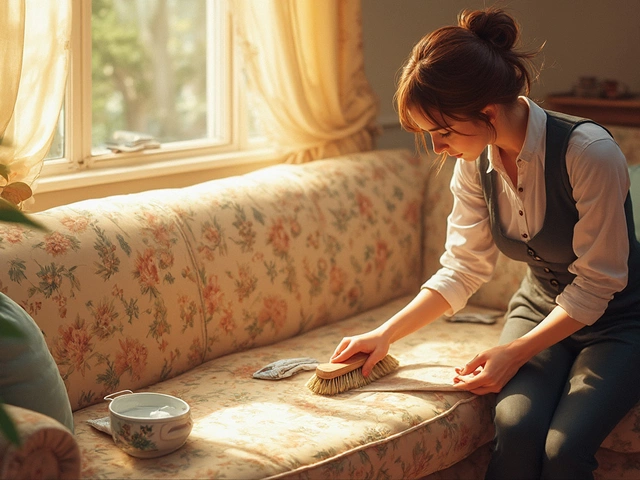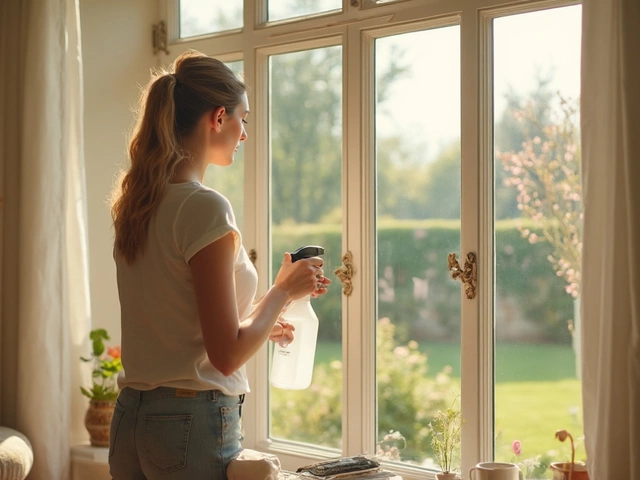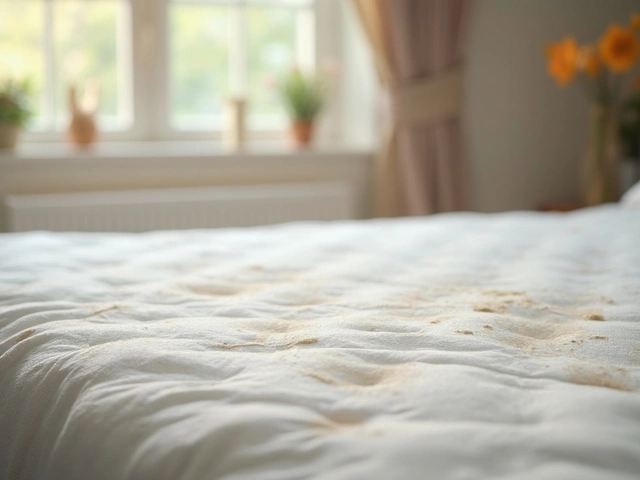Ever wondered why everyone makes such a big deal out of spring cleaning? It’s not just an old-school tradition. After months of winter hibernation, your place probably has dust in weird corners, forgotten junk in closet nooks, and a stale air you can practically taste. Spring cleaning gives you the push to tackle all of it at once—think of it as hitting the reset button, but for your whole living space.
What’s wild is that studies from big-name universities keep finding the same thing: a cluttered room really can mess with your head. People who set aside a weekend or even just a few targeted hours to clear out, wipe down, and reorganize end up reporting less stress and even sleep better. No fancy products needed—just a bit of grit and some trash bags.
- Ancient Roots and Modern Reasons
- The Real Mental Benefits
- Hidden Dirt Hotspots
- Tips That Actually Work
- Keeping the Momentum
Ancient Roots and Modern Reasons
Spring cleaning isn’t just a thing your grandma made up. It actually goes way back. Historians point out that people in ancient Persia kicked off the new year with a huge house cleaning called “khaneh tekani.” Jews did a full-on scrub before Passover to clear out every crumb. And if you look at old American traditions, folks would wait until the weather warmed up so they could fling open all the windows and finally shake out all the soot from their coal-burning stoves. Kind of makes our yearly dust wars feel universal, right?
But why do we still do it now, when we’ve got dishwashers and robot vacuums? For one, modern life means mess just builds up faster. You’ve got the Amazon boxes, workout gear, work-from-home setup—all of it piles up. And science backs up the need for a reset. According to a 2023 poll by the American Cleaning Institute, 78% of people reported feeling less anxious with a fresh, clean living space. It’s not just about spotless counters; it’s about a clear mind.
Here’s a quick look at how spring cleaning has played out across different times and places:
| Time/Place | Cleaning Tradition | Reason |
|---|---|---|
| Ancient Persia | Khaneh Tekani | New year refresh |
| Jewish Passover | Home deep-clean | Remove leaven |
| Victorian England | Dust & soot cleaning | Spring warmth allows windows open |
| Modern US | Spring cleaning | Clutter bust & stress relief |
The modern twist? It’s not just about cleaning top to bottom. Now, people use it as a chance to do a quick home inventory, donate old stuff, or even swap out heavy bedding and coats for lighter ones. It’s way more than just wiping counters—it’s about setting yourself up for a smoother, lighter few months ahead.
The Real Mental Benefits
If you’ve ever cleaned out your closet and suddenly felt like it got way easier to breathe, that’s not just your imagination. There’s real science behind the mental boost you get from spring cleaning. For example, a study by the Personality and Social Psychology Bulletin found that people with cleaner homes report feeling happier and less stressed overall. When you clear out mess and clutter, your brain doesn’t have to work as hard to keep track of everything. Less background stress means more room to actually relax.
It’s not just about how you feel in the moment. Cleveland Clinic published data showing that tackling a big deep-clean can reduce symptoms of anxiety and even help with focus, especially if you’re working from home. Basically, when your surroundings make sense, your mind chills out.
| Study or Source | Main Finding |
|---|---|
| UCLA Center on Everyday Lives | Cluttered homes led to increased levels of cortisol, the stress hormone. |
| Personality and Social Psychology Bulletin | Visible mess in homes strongly correlated with negative mood. |
| Cleveland Clinic | Cleaning activities linked to lower rates of anxiety and higher productivity. |
Look, nobody’s pretending scrubbing the bathtub is their idea of a great time. But finishing a big cleaning job gives you a weird sense of control—like you’re the boss of your own space again. That feeling can actually boost your mood for days, not just right after you put the vacuum away.
- If you’re overwhelmed, pick just one shelf or drawer. Small wins add up fast.
- Set a timer—10 or 20 minutes tops—and focus just on one task so you don’t stall out.
- Put on a playlist or podcast to keep your energy up while you work.
The takeaway: clearing out physical clutter helps clear up mental clutter. You don’t have to go overboard, but making a dent in the mess can actually make your brain less frazzled. That’s a win on any level.

Hidden Dirt Hotspots
Ever notice how some spots always seem gross, no matter how often you wipe the counters? During spring cleaning, these trouble zones deserve extra attention. The biggest offenders? Light switches, door handles, remote controls, and the tops of picture frames. Studies from home hygiene experts say these spots have way more germs than your toilet seat because we forget to clean them.
Your kitchen sink is a whole other story. Even if it looks clean, the drain and faucet are often swarming with bacteria. Run boiling water down the drain, scrub around the faucet with an old toothbrush, and don’t forget the garbage disposal—drop in lemon peel and run it with cold water for a quick, fresh reset.
Then there’s your fridge. You open it a hundred times a week, but when did you last wipe the shelves or the rubber seal around the door? Food spills, crumbs, and mold can hang out for months. Pull out the drawers, clean underneath, and give the doors and seals a good scrub.
- Ceiling fans: Dust piles up fast, then spins through the house every time you turn them on.
- Baseboards: They collect hair, dust, and mystery grime, especially behind furniture.
- Under beds and couches: If you haven’t looked down there lately, you’re probably storing a scary amount of dust bunnies and lost socks.
Last one—your washing machine. Mold can build up in the detergent tray and around the rubber seal. Run an empty hot cycle with vinegar to keep it fresh. These little spots make a big difference in how your home actually feels after cleaning, so add them to your checklist instead of glossing over them.
Tips That Actually Work
Let’s cut through the endless lists and get right to the stuff that makes spring cleaning smoother. You don’t need a ten-hour playlist, a checkout cart full of fancy sprays, or to follow any viral hacks from people who apparently live in spotless mansions. Instead, use what actually works for real-life mess and real-life schedules.
- Spring cleaning works best when you pick one area at a time. Don’t sprint between rooms or you’ll end up with twice the chaos. Treat the kitchen, for example, as its own beast—clear surfaces first, then tackle the fridge, cupboards, and drawers. Focus lets you finish.
- Always declutter before you clean. Americans, on average, spend over 2.5 days a year just looking for lost stuff. Go through drawers, shelves, and baskets with a trash bag and a donate box. If you haven’t used it in a year, odds are you won’t miss it.
- Put your supplies together in a small caddy or bucket. This saves you from trekking across the house for a missing rag or all-purpose spray. Basic gear: microfiber cloths, an all-purpose cleaner, glass cleaner, and a tough brush for grimy spots.
- Don’t forget the out-of-sight, out-of-mind spots. Light fixtures, behind appliances, and vents collect dust and allergens like magnets. The EPA actually recommends cleaning air vents every spring to help with allergies.
- If you’re short on time, try the "power hour." Set a timer for 60 minutes, blast music if you want, and work nonstop on just one zone (bathroom, living room, wherever needs help). You’ll be shocked at what you can knock out in an hour when you focus hard.
Lastly, label bins or boxes for what you’re keeping. This saves you from a repeat mess in a few months and helps family or roommates know where stuff goes after you’re done. You’ll walk away with clearer counters, less junk, and a space that actually feels refreshing.

Keeping the Momentum
Finishing your big spring cleaning push feels awesome, but it’s way too easy to slide right back into old habits. The mess creeps back unless you make a plan to keep things under control. Most folks go hard for a weekend, but the real trick is working in small habits that keep your space tidy day to day. According to a 2023 survey by the National Cleaning Institute, people who did a quick ten-minute clean each evening reported 40% less stress about mess in their homes.
The best way to keep that tidy vibe going? Set up routines you barely have to think about. Here are a few that actually work:
- Pick one task for each day—like clearing kitchen counters or putting away laundry—so nothing piles up.
- Keep a donation box nearby. If you stumble on stuff you don’t use, toss it in and drop it off once a month.
- Make things easy for future you. Store cleaning supplies where you use them the most—spray in the bathroom, wipes in the kitchen, a lint roller by the pet beds.
- Get everyone involved. Even five-minute family pick-ups add up when done regularly.
If you’re the data nerd type, check out this quick rundown from a 2024 study on cleaning routines and clutter perception:
| Cleaning Routine | Average Clutter Score* | Reported Satisfaction (%) |
|---|---|---|
| Daily mini-tidies | 2/10 | 82 |
| Weekly big clean | 5/10 | 59 |
| Spot cleaning (random) | 7/10 | 33 |
*Lower score means less clutter, according to survey participants.
Habits are where the real difference happens. Skip perfection—aim for progress. Even if you fall off the wagon one week, jump right back in with a small win. The payoff is a place that just feels better to live in, not just once a year but all the time.




